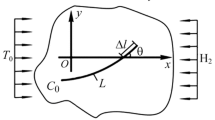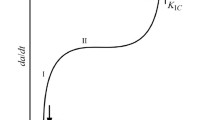Abstract
Hydride precipitation ahead of a crack is examined under conditions of hydrogen chemical equilibrium, constant temperature and elastic-plastic power-law hardening metal behavior. The limiting conditions are approached via the interaction of the operating physical mechanisms of material deformation, hydrogen diffusion and hydride precipitation. Hydrides are characterized by hydride volume fraction and isotropic transformation strain. Analytical relations are presented for hydride volume fraction and stress, as well as for hydride precipitation zone boundary. It is shown that there is an annulus, within the hydride precipitation zone, where stresses, although vary according to \({\left(1/r\right)}^{1/n+1}\) -singularity, deviate significantly from the well-known HRR-field, being smaller, according to the difference of hydrostatic stress before and after hydride precipitation. Hydride precipitation zone increases with crack-tip constraint, given by triaxiality parameter \(Q\).






Similar content being viewed by others
References
Al Laham S (1998) Stress intensity factor and limit load handbook. British Energy Generation Ltd, EPD/GEN/REP/0316/98 Issue 2
Andersson P, Bergman M, Brickstad B, Dahlberg L, Nilsson F, Sattari-Far I (1996) A procedure for safety assessment of components with cracks – Handbook, 3rd edition. SAQ KONTROLL AB, SAQ/FoU-Report 96/08
Arsene S, Bai JB, Bompard P (2003a) Hydride embrittlement and irradiation effects on the hoop mechanical properties of pressurized water reactor (PWR) and boiling-water reactor (BWR) zircaloy cladding tubes: part I. hydride embrittlement in stress-relieved, annealed, and recrystallized zircaloys at 20oC and 300oC. Metall Mater Trans A 34A:553–566
Arsene S, Bai JB, Bompard P (2003b) Hydride embrittlement and irradiation effects on the hoop mechanical properties of pressurized water reactor (PWR) and boiling-water reactor (BWR) zircaloy cladding tubes: part III. Mechanical behavior of hydride in stress-relieved annealed and recrystallized zircaloys at 20oC and 300oC. Metall Mater Trans A 34A:579–588
Bai JB, Francois D (1992) Some evidence of a brittle-ductile transition of zirconium hydride between 20 and 350oC. J Nucl Mater 187:186–189
Bai JB, Prioul C, Francois D (1994) Hydride embrittlement in zircaloy-4: part I. influence of microstructure on the hydride embrittlement in zircaloy-4 at 20oC and 350oC. Metall Mater Trans A 25A:1185–1197
Barrera O, Bombac D, Chen Y, Daff TD, Galindo-Nava E, Gong P, Haley D, Horton R, Katzarov I, Kermode JR, Liverani C, Stopher M, Sweeney F (2018) Understanding and mitigating hydrogen embrittlement of steels: a review of experimental, modelling and design progress from atomistic to continuum. J Mater Sci 53:6251–6290
Betegon C, Hancock JW (1991) Two parameter characterization of elastic-plastic crack tp fields. J Appl Mech 58:104–110
Broberg KB (1999) Cracks and fracture. Academic Press, London
Carpenter GJC (1973) The dilatational misfit of zirconium hydrides precipitated in zirconium. J Nucl Mater 48:264–266
Cherepanov GP (1967) Crack propagation in continuous media. J Appl Math Mech 31:503–512
Dadfarnia M, Nagao A, Wang S, Martin ML, Somerday BP, Sofronis P (2015) Recent advances on hydrogen embrittlement of structural materials. Int J Fract 196:223–243
Denbigh KG (1951) The thermodynamics of the steady state. Methuen & CO, London
Earmee YY, Johnson WC, Lee JK (1981) Plastic relaxation of the transformation strain energy of a misfitting spherical precipitate: Linear and power-law strain hardening. Metall Trans A 12A:1521–1530
Efsing P (1998) Delayed hydride cracking in irradiated zircaloy, Thesis PhD Royal Institute of Technology, Stockholm
Eshelby JD (1957) The determination of the elastic field of an ellipsoidal inclusion, and related problems. Proc Royal Soc 241:376–396
Hutchinson JW (1968) Plastic stress and strain fields at a crack tip. J Mech Phys Solids 16:337–347
Lee JK, Earmee YY, Aaronson HI, Russell KC (1980) Plastic relaxation of the transformation strain energy of a misfitting spherical precipitate: Ideal plastic behavior. Metall Trans A 11A:1837–1847
Lufrano J, Sofronis P, Birnbaum HK (1998) Elastoplastically accommodated hydride formation and embrittlement. J Mech Phys Solids 46:1497–1520
O’Dowd NP, Shih CF (1991) Family of crack tip fields characterized by a triaxiality parameter - I. structure of fields. J Mech Phys Solids 39:989–1015
O’Dowd NP, Shih CF (1992) Family of crack tip fields characterized by a triaxiality parameter - IΙ. Fracture applications. J Mech Phys Solids 40:939–963
O’Dowd NP, Shih CF (1994) Two-parameter fracture mechanics: theory and applications. ASTM STP 1207:21–47
Pardee WJ, Paton NE (1980) Model of sustained load cracking by hydride growth in Ti alloys. Metall Trans A 11A:1391–1400
Rashid MS, Scott TE (1973) Crystal structure of niobium hydride. J Less-Common Met 30:399–403
Rice JR (1968) A path independent integral and the approximate analysis of strain concentration by notches and cracks. J Appl Mech 35:379–387
Rice JR, Rosengren GF (1968) Plane strain deformation near a crack tip in a power-law hardening material. J Mech Phys Solids 16:1–12
Shewmon P (1989) Diffusion in solids. The Minerals, Metals & Materials Society, Warrendale
Symington M, Shih CF, Ortiz M (1988) Tables of plane strain mixed-mode plastic crack tip fields. Brown University, Providence
Tada H, Paris PC, Irwin GR (2000) The stress analysis of cracks handbook 3. ASME Press, New York
Varias AG (2022) Hydrogen distribution in metals under chemical equilibrium and steady-state heat conduction. Euro Harmonization & Engineering. https://doi.org/10.13140/RG.2.2.18987.31522
Varias AG (2023) Elastic crack-tip field in hydride forming metals under hydrogen chemical equilibrium. Int J Fract. https://doi.org/10.1007/s10704-023-00752-5
Varias AG, Feng JL (2004a) Simulation of hydride-induced steady-state crack growth in metals – part I: growth near hydrogen chemical equilibrium. Comput Mech 34:339–356
Varias AG, Feng JL (2004b) Simulation of hydride-induced steady-state crack growth in metals – part II: General near-tip field. Comput Mech 34:357–376
Varias AG, Massih AR (2000) Simulation of hydrogen embrittlement in zirconium alloys under stress and temperature gradients. J Nucl Mater 279:273–285
Varias AG, Massih AR (2002) Hydride-induced embrittlement and fracture in metals – effect of stress and temperature distribution. J Mech Phys Solids 50:1469–1510
Varias AG, Shih CF (1993) Quasi-static crack advance under a range of constraints - steady-state fields based on a characteristic length. J Mech Phys Solids 41:835–861
Williams ML (1957) On the stress distribution at the base of a stationary crack. J Appl Mech 24:109–114
Xia Z, Zang J, Tong Q, Ding S (2019) Multi-physics modeling of delayed hydride cracking in zirconium alloys. J Mech Phys Solids 132:103677
Acknowledgements
The study was performed within Euro-Harmonization and Engineering, an activity for the understanding of mechanics, related to present and future industrial needs.
Author information
Authors and Affiliations
Contributions
The study was performed, by A.G. Varias, within Euro-Harmonization and Engineering.
Corresponding author
Ethics declarations
Competing interest
The authors declare no competing interests.
Additional information
Publisher’s Note
Springer Nature remains neutral with regard to jurisdictional claims in published maps and institutional affiliations.
Rights and permissions
Springer Nature or its licensor (e.g. a society or other partner) holds exclusive rights to this article under a publishing agreement with the author(s) or other rightsholder(s); author self-archiving of the accepted manuscript version of this article is solely governed by the terms of such publishing agreement and applicable law.
About this article
Cite this article
Varias, A.G. Elastic-plastic crack-tip field in hydride forming metals under hydrogen chemical equilibrium. Int J Fract (2024). https://doi.org/10.1007/s10704-024-00766-7
Received:
Accepted:
Published:
DOI: https://doi.org/10.1007/s10704-024-00766-7




